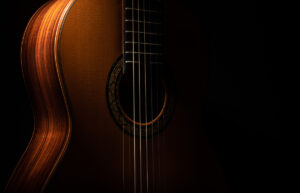How to Tune a Guitar? Tips for Beginners

Tuning a guitar is a fundamental skill for any guitarist, whether you’re a beginner or a seasoned professional. It’s crucial for achieving optimal sound quality and playing harmoniously.
Are you looking to learn how to tune a guitar to make it sound appropriate? This guide highlights the step-by-step process of tuning a guitar using a standard tuning method and offers tips on maintaining the tuning for longer periods.
Let’s dive in!
Welcome to TheDemoStop, now join the community!
Connect with artists, fans and producers around the world.
How To Tune A Guitar?
Understand the Guitar Strings
The initial step in learning how to tune a guitar is understanding its strings. A standard guitar is equipped with six strings, each tuned to a specific note. These strings are numbered from the thinnest—the 1st string, to the thickest, referred to as the 6th string. The standard tuning for each string from the lowest pitch (6th string) to the highest pitch (1st string) is as follows:
- 6th string: E (low E)
- 5th string: A
- 4th string: D
- 3rd string: G
- 2nd string: B
- 1st string: E (high E)
To learn the strings in a hierarchy is Eddie Ate Dynamite, Good Bye Eddie!
Use a Tuner
In the process of how to tune a guitar, having a tuner is mandatory. It is a device that helps you tune your guitar by indicating whether the note you are playing is too high (sharp) or too low (flat). There are different types of tuners:
- Clip-on tuners: These tuners are attached to the guitar’s headstock and detect the pitch through vibrations.
- Pedal tuners: These are plugged into the signal chain and are used by electric guitarists.
- App tuners: These tuners are available on smartphones and use microphones to detect pitch.
Start With the Low E String (6th String)
- Pluck the low E string (6th string) and observe the tuner.
- If the tuner indicates the note is flat (too low), tighten the tuning peg (clockwise) to raise the pitch.
- If the note is sharp (too high), loosen the tuning peg (counterclockwise) to lower the pitch.
- Continue adjusting until the tuner shows that the string is in tune, typically indicated by a green light or the needle being centered.
Move to the A String (5th String)
- Pluck the A (5th string).
- Follow the same process as the low E string.
- Adjust the tuning peg until the tuner indicates that the string is in tune.
- Continue making adjustments until the tuner shows that the string is in tune.
Tune the D String (4th String)
- Pluck the D string (4th string).
- Adjust the tuning peg according to the tuner’s feedback until the string is in tune.
Tune the G String (3rd String)
- Pluck the G string (3rd string).
- Keep adjusting the tuning peg until the tuner shows the string is in tune.
Tune the B String (2nd String)
- Pluck the B string (2nd string).
- Adjust the peg until the tuner indicates the string is in tune.
Welcome to TheDemoStop, now join the community!
Connect with artists, fans and producers around the world.
Tune the high E String (1st String)
- Pluck the high E string (1st string).
- Adjust until the tuner shows the string is in tune.
Check Your Tuning
After tuning all strings, pluck them again to ensure they are still in tune. Adjusting one string can affect the others, especially if the guitar is new or the strings are recently replaced. This step ensures that your guitar is accurately tuned across all strings, providing optimal sound quality.
Fine-Tuning
Fine-tuning involves making small adjustments to each string to ensure they are perfectly in tune. Play some chords or a chromatic scale to check if everything sounds correct. Listen carefully for any discrepancies and make adjustments as necessary to achieve accurate tuning.
Stretching the Strings
The final step in how to tune a guitar is to stretch the strings, which helps maintain tuning stability. To do this, gently pull each string away from the fretboard and then retune the string. Repeat this process a few times until the strings hold their pitch better.
How To Keep Your Guitar in Tune Longer
Change Your Strings Often
Depending on how often you play, changing strings can range from every few weeks to a few months. Professional or frequent players may need to change strings more often, while casual players might do so every 2-3 months. Regularly replacing strings ensures optimal sound quality and playability.
- Signs of wear: Look for discoloration, difficulty in tuning, loss of tone, or a rough texture. These indicate the strings are worn out and need replacement.
- Benefits: New strings stay in tune better because they have not been stretched or weakened. They also sound brighter and more resonant.
Stretch Your Guitar Strings
When you first put on new strings, gently stretch them by pulling each string away from the fretboard. This process helps the strings settle and stabilize, ensuring they hold their tune more effectively. To stretch your strings, follow the below steps:
- After tuning your guitar, gently pull each string upward, away from the fretboard, around the 12th fret.
- Retune the string, as it will likely have gone flat after stretching.
- Repeat this process a few times until the string holds its pitch.
Take Care of Your Guitar
While learning how to tune a guitar, here are a few tips to learn how to take care of your guitar:
- Temperature and humidity: Keep your guitar in a stable environment. Extreme temperatures and humidity can expand or contract the wood, affecting tuning.
- Use a hygrometer to monitor humidity.
- Store your guitar in a case with a humidifier or dehumidifier as needed.
- Proper storage: When not in use, store your guitar in a hard case. This will protect it from physical damage and environmental changes.
- Cleaning: Clean your strings and fretboard regularly. Dirt, sweat, and body oils can corrode strings and affect tuning stability.
- Use a clean cloth to wipe down strings after each use.
- Use specialized guitar cleaning products for a deeper clean periodically.
- Check hardware: Ensure tuning pegs, bridges, and other hardware are secure. Loose components can cause tuning instability.
- Tighten any loose tuning pegs.
- Inspect and adjust the bridge and nut if necessary.
Welcome to TheDemoStop, now join the community!
Connect with artists, fans and producers around the world.
Conclusion
How to tune a guitar?
- Understand the guitar strings
- Use a tuner
- Start with the low E string (6th string)
- Move to the A string (5th string)
- Tune the D string (4th string)
- Tune the G string (3rd string)
- Tune the B string (2nd string)
- Tune the high E string (1st string)
- Check your tuning
- Fine-tuning
- Stretching the strings
How to keep your guitar in tune longer?
- Change your strings often
- Stretch your guitar strings
- Take care of your guitar
FAQs
What is the standard tuning for a guitar?
The standard tuning for a guitar is E-A-D-G-B-E, from the lowest (thickest) string to the highest (thinnest) string:
- 6th string: E (low E)
- 5th string: A
- 4th string: D
- 3rd string: G
- 2nd string: B
- 1st string: E (high E)
What is the easiest tuning to play on a guitar?
The easiest tuning to play on a guitar is often considered standard tuning (E-A-D-G-B-E) because it is the most widely used and is the basis for most instructional materials and chord charts. For absolute beginners, Open G tuning (D-G-D-G-B-D) can also be effortless, as it allows for simple chord shapes and is great for playing slide guitar.
How can I make my guitar stay in tune longer?
- Change your strings often
- Stretch your guitar strings
- Take care of your guitar to avoid wear and tear
How often should you tune your guitar?
Tune your guitar every time you play it. Frequent tuning ensures that your instrument sounds its best and helps you develop a good ear for pitch.
How do you know if your guitar is tuned properly?
You know your guitar is tuned correctly when each string matches the correct pitch for its note (E-A-D-G-B-E for standard tuning) and sounds harmonious when played together.








































